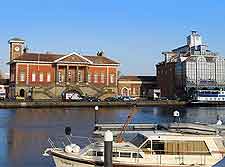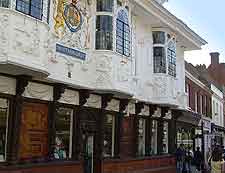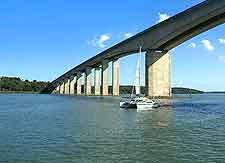Ipswich History Facts and Timeline
(Ipswich, Suffolk, England)

The town of Ipswich is steeped in history. Its earliest origins may lie in the Roman period. Indeed, there is some evidence of a Roman villa on the site. However, it's not until Anglo-Saxon times that a small village grew here. It had its own church, dedicated to St. Mildred.
These Anglo-Saxon settlers named the town Gippeswyc, which may refer to the name of one of its leaders. Alternatively, it could be derived from 'gip', meaning 'corner of the mouth' and possibly relate to the Gipping River, which enters the Orwell estuary.
Medieval History
Ipswich soon grew into a fairly prosperous town, with a population of around 2,000 people. In 1200, a Charter was granted by King John. It allowed the townsfolk certain rights, including its own courts and bailiffs. At this time, Ipswich was mainly involved in the making and selling of woollen cloth. Other medieval industries included leather working and brewing. The town had its own markets at Corn Hill, on Tavern Street and in the Buttermarket area. It also had an annual fair. Two priories were established, along with many churches, including St. Mary at the Quay, St. Peter's and St. Stephen's.
By King Edward III's reign in the 14th century, Ipswich is noted as being one of the richest ports in England. Many merchants built houses by the river. The port was used to transport troops to the Battle of Crécy in 1346.

Tudor Times to the 18th Century
Cardinal Thomas Wolsey was born here in 1475. As King Henry VIII's Chancellor and ally, he went on to found a college in the town. By the early 16th century, Ipswich had been made a King's Port and the shipbuilding industry was well established. Many explorers started out on their adventures from the port. Later, it also became a major centre for departing emigrants. One of them, Nathaniel Ward, went on to found Ipswich, Massachusetts.
In the 18th century, the town had a number of artistic connections. At that time, it would have been possible to spot the famous artist Thomas Gainsborough at work here. John Constable was also born in the area and is thought to have often visited the town to paint.

From the 19th Century to the Present
The town's literary connections continued into the 19th century, when Charles Dickens stayed here. It's believed that certain local people inspired many of the characters that appeared in 'Pickwick Papers', as did the hotel in which he stayed.
As a port, Ipswich had seen some decline from the 18th century on, probably for want of better port facilities. In 1805, permission was finally granted to improve the town's dock and in 1937, a wet dock was constructed. Work on the Old Custom House was completed in 1845 and the Ipswich Town Hall was built in 1878.
During more recent history, Ipswich has continued to evolve and in 1963, work began on extensive civic centre redevelopment, not all of which was well received. In 1975, the architect Sir Norman Foster designed and completed the glass-fronted Willis Building, which is the youngest Grade I listed building in Britain, while in 2008, the town's Wet Dock became the home of the main hub of the University Campus Suffolk (UCS).
 The town of Ipswich is steeped in history. Its earliest origins may lie in the Roman period. Indeed, there is some evidence of a Roman villa on the site. However, it's not until Anglo-Saxon times that a small village grew here. It had its own church, dedicated to St. Mildred.
The town of Ipswich is steeped in history. Its earliest origins may lie in the Roman period. Indeed, there is some evidence of a Roman villa on the site. However, it's not until Anglo-Saxon times that a small village grew here. It had its own church, dedicated to St. Mildred.
